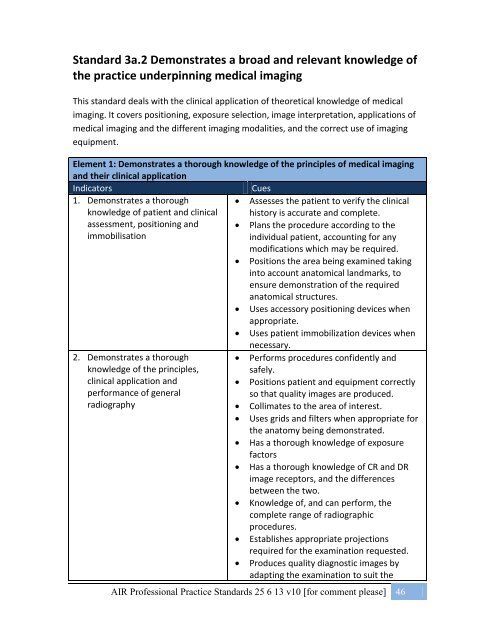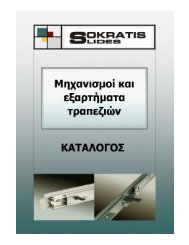Australian-Professional-Standards-Practices
You also want an ePaper? Increase the reach of your titles
YUMPU automatically turns print PDFs into web optimized ePapers that Google loves.
Standard 3a.2 Demonstrates a broad and relevant knowledge of<br />
the practice underpinning medical imaging<br />
This standard deals with the clinical application of theoretical knowledge of medical<br />
imaging. It covers positioning, exposure selection, image interpretation, applications of<br />
medical imaging and the different imaging modalities, and the correct use of imaging<br />
equipment.<br />
Element 1: Demonstrates a thorough knowledge of the principles of medical imaging<br />
and their clinical application<br />
Indicators<br />
Cues<br />
1. Demonstrates a thorough<br />
knowledge of patient and clinical<br />
• Assesses the patient to verify the clinical<br />
history is accurate and complete.<br />
assessment, positioning and<br />
immobilisation<br />
• Plans the procedure according to the<br />
individual patient, accounting for any<br />
modifications which may be required.<br />
• Positions the area being examined taking<br />
into account anatomical landmarks, to<br />
ensure demonstration of the required<br />
anatomical structures.<br />
• Uses accessory positioning devices when<br />
appropriate.<br />
• Uses patient immobilization devices when<br />
2. Demonstrates a thorough<br />
knowledge of the principles,<br />
clinical application and<br />
performance of general<br />
radiography<br />
necessary.<br />
• Performs procedures confidently and<br />
safely.<br />
• Positions patient and equipment correctly<br />
so that quality images are produced.<br />
• Collimates to the area of interest.<br />
• Uses grids and filters when appropriate for<br />
the anatomy being demonstrated.<br />
• Has a thorough knowledge of exposure<br />
factors<br />
• Has a thorough knowledge of CR and DR<br />
image receptors, and the differences<br />
between the two.<br />
• Knowledge of, and can perform, the<br />
complete range of radiographic<br />
procedures.<br />
• Establishes appropriate projections<br />
required for the examination requested.<br />
• Produces quality diagnostic images by<br />
adapting the examination to suit the<br />
AIR <strong>Professional</strong> Practice <strong>Standards</strong> 25 6 13 v10 [for comment please] 46

















